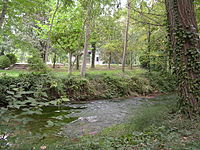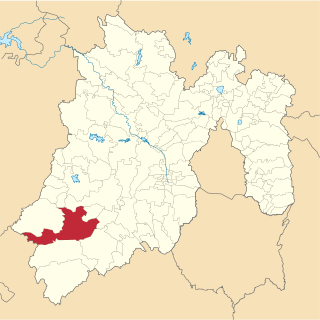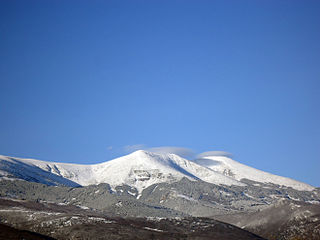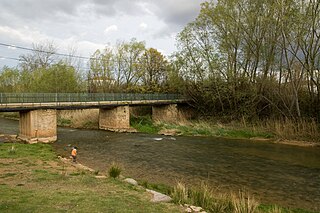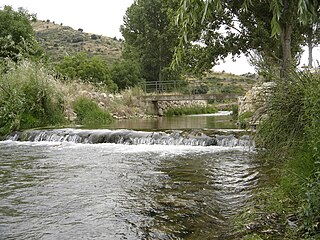| Mesa River (Río Mesa) | |
|---|---|
View of the Mesa River in Jaraba | |
The watershed of the Piedra within the Ebro basin | |
| Country | Spain |
| Physical characteristics | |
| Main source | Sierra de Solorio, Guadalajara Province Castile-La Mancha 1,272 m (4,173 ft) |
| River mouth | Piedra River La Tranquera Dam, Aragón 691 m (2,267 ft) 41°14′33″N1°48′37″W / 41.24250°N 1.81028°W Coordinates: 41°14′33″N1°48′37″W / 41.24250°N 1.81028°W |
| Length | 54.17 kilometres (33.66 mi) |
| Basin features | |
| Progression | Piedra - Jalón- Ebro - Mediterranean Sea |
| River system | Ebro |
The Mesa River (Spanish : Río Mesa) is a river in the Sierra de Solorio range area, Iberian System, Spain. It is a tributary of the Piedra River.

Spanish or Castilian is a Romance language that originated in the Castile region of Spain and today has hundreds of millions of native speakers in the Americas and Spain. It is a global language and the world's second-most spoken native language, after Mandarin Chinese.

The Solorio Range is a mountain range located in the western side of the Iberian System, Spain. It straddles Aragon, Castile-La Mancha and Castile and León.

Spain, officially the Kingdom of Spain, is a country mostly located in Europe. Its continental European territory is situated on the Iberian Peninsula. Its territory also includes two archipelagoes: the Canary Islands off the coast of Africa, and the Balearic Islands in the Mediterranean Sea. The African enclaves of Ceuta, Melilla, and Peñón de Vélez de la Gomera make Spain the only European country to have a physical border with an African country (Morocco). Several small islands in the Alboran Sea are also part of Spanish territory. The country's mainland is bordered to the south and east by the Mediterranean Sea except for a small land boundary with Gibraltar; to the north and northeast by France, Andorra, and the Bay of Biscay; and to the west and northwest by Portugal and the Atlantic Ocean.
Contents
There are trout in the river, but the population of the endangered European freshwater crayfish in the river has practically disappeared owing to the introduction of the North American signal crayfish (Pacifastacus leniusculus). [1]

Trout is the common name for a number of species of freshwater fish belonging to the genera Oncorhynchus, Salmo and Salvelinus, all of the subfamily Salmoninae of the family Salmonidae. The word trout is also used as part of the name of some non-salmonid fish such as Cynoscion nebulosus, the spotted seatrout or speckled trout.

Austropotamobius pallipes is an endangered European freshwater crayfish, and the only species of crayfish native to the British Isles. Its common names include white-clawed crayfish and Atlantic stream crayfish.

North America is a continent entirely within the Northern Hemisphere and almost all within the Western Hemisphere; it is also considered by some to be a northern subcontinent of the Americas. It is bordered to the north by the Arctic Ocean, to the east by the Atlantic Ocean, to the west and south by the Pacific Ocean, and to the southeast by South America and the Caribbean Sea.
